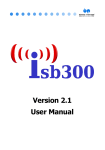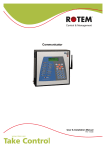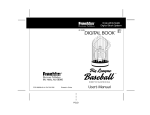Download User Manual - B&H Photo Video
Transcript
PhotoTools User Guide User Manual Created: Sunday, November 21, 2010 Table of Contents 1 Welcome Using this Help System Additional Resources Contacting onOne Software 2 Installation System Requirements Installation Uninstalling Activation and Registration 1 2 3 4 5 6 7 8 9 3 What is New in PhotoTools 10 4 Getting Started 11 When to use PhotoTools Supported File Types Opening PhotoTools User Interface Navigating the Preview Preview Modes 5 Using PhotoTools Using the Effects Library Opening the Library Searching Browsing Categories Keyword Browser Results Pane Details and Previews Presets Browsing Presets Using Presets Saving Presets Deleting Presets Sharing Presets Using the Effects Stack Effect Options Hiding Effects Changing the Order of Effects Removing and Effect Adjusting the Fade Using the Mini-Library Using the Masking Tools Masking Controls Painting-In Painting-Out Using the MaskingBug MaskingBug Shapes Adjusting the MaskingBug 12 13 14 15 17 19 21 22 23 24 25 26 27 28 29 30 31 32 33 34 35 36 37 38 39 40 41 42 43 45 46 47 48 49 Adding Layer Masks Preferences Video Clip Support onOne Panel and Menu Photoshop Lightroom Use Applying a Preset Manual Use Batch Processing Aperture Use Using Presets Manual Use Batch Processing Stack Tab Source Tab Destination Tab File Naming Tab File Type Tab Watermark Tab Logging 6 Examples Waterfall Example Bride Example Tulip Example 7 Menus Photoshop Mac OSX File Edit View Window Help Keyboard Shortcuts 52 53 55 56 57 58 60 62 63 64 65 66 67 68 69 70 72 73 75 76 77 79 81 83 84 85 86 87 88 89 90 Welcome . 1 PhotoTools User Guide Welcome to onOne Software PhotoTools 2.6 PhotoTools 2.6 Professional is the fastest and easiest way to add a professional look to your photos in Photoshop. You get hundreds of professional-grade photographic effects, all wrapped up in an easy-to-use Photoshop plug-in making this the fastest and easiest way to make your photos stand out from the crowd. The key to PhotoTools 2.6 Professional Edition is its unique ability to provide full-screen previews of an effect on your image before you choose to apply it. PhotoTools 2.6 is like Legos® for Photoshop. You can stack multiple effects on top of each other just like you would filters over a camera lens. You can then control the order of each effect and how they blend together for a truly unique look. You can even save your effect stacks for future use and share them with your friends who have PhotoTools or access them inside of Aperture and Lightroom to speed-up your workflow. ● Includes hundreds of professional effects created by top photographers and Photoshop Hall-of-Famers. ● Stack multiple effects to create your own look, then save it as a preset you can use in one-click from Photoshop, Lightroom or Aperture. ● NEW MaskingBug and MaskingBrush makes selectively placing and blending multiple effects a snap. ● The most complete and powerful tool in your Photoshop arsenal. Looking for Information? If you're unable to find what you're looking for in this help system, try these alternative resources, or contact our customer support department. Most popular pages ● Welcome ● Additional Resources ● System Requirements ● Browsing Categories ● What is New in PhotoTools ● Contacting onOne Software ● Using this Help System ● Installation ● User Interface ● Installation rev 2.6 101121dh PhotoTools User Guide 2 . Welcome Home > Welcome > Using this Help System Using this Help System The user guide for PhotoTools 2.6 is presented in html and is readable in most web browsers. When you access the user guide from the help menu it will appear in your default web browser. On the right side you will see a table of contents that makes it easy to find the section you are looking for. The table of contents are hyperlinks that will take you to the specified section by clicking on them. The main body of the page will show you the content you have requested. Use the scroll-bar at the right to scroll down for additional content. You may see additional hyperlinks in the body text. They will be blue and underlined. Clicking on one of these hyperlinks will take you to more relevant information. You use the same forward and back buttons in your browser to navigate this user guide as you would a regular web page. You can even bookmark pages so you can find them quickly in the future. If you don't see what you are looking for in the table of contents, try the search field. You can type in what you are looking for and an index of pages will be created automatically that contain your search term. Printing the Manual You can also access a printable version of this manual here. It is in Adobe Acrobat (PDF) format. You will need a copy of the free Adobe Acrobat Reader to view it. See also Additional Resources Contacting onOne Software PhotoTools User Guide Welcome . 3 Home > Welcome > Additional Resources Additional Resources Knowledge Base Search the Knowledge Base for common bugs, tips & tricks, and compatibility issues with other software. Video Tutorials Check the online video tutorials. Technical Support Contact technical support by filing out a request form. PhotoTools User Guide 4 . Welcome Home > Welcome > Contacting onOne Software Contacting onOne Software onOne Software, Inc. 15333 SW Sequoia Parkway Suite 150 Portland, OR 97224 Phone Main: 503-968-1468 Fax: 503-968-1469 http://www.onOnesoftware.com For Technical Support please visit: http://www.onOnesoftware.com/support Sales For sales please call 1-888-968-1468 See also Using this Help System Additional Resources © 2010 onOne Software, Inc. All rights reserved. onOne Software is a registered trademark of onOne Software, Inc. The onOne Software logo, and PhotoTools are trademarks of onOne Software, Inc. Adobe, Photoshop, Photoshop Elements, Photoshop Lightroom, Flash and Acrobat are trademarks of Adobe Systems, Incorporated. Mac OSX, the Mac logo and Aperture are trademarks of Apple, Inc., registered in the U.S. and other countries. Microsoft, Windows, Windows XP, Windows Vista and .NET are registered trademarks of Microsoft Corporation. All other trademarks are the property of their respective owners. PhotoTools User Guide Installation . 5 Home > Installation Articles in this section System Requirements Installation Uninstalling Activation and Registration PhotoTools User Guide 6 . Installation Home > Installation > System Requirements System Requirements Macintosh Operating System Mac OSX 10.5, 10.6 (current maintenance releases) Windows Windows XP, Windows Vista, Windows 7 (current maintenance releases) Processor 1.8 GHz Intel or better 1.8GHz Intel or better Memory 2GB RAM 2GB RAM Hard Disk 200 MB Hard Disc Space 200 MB Hard Disc Space Display OpenGL 2.0 capable video card with 256MB VRAM running at 1024x768 (1280x1024 or higher recommended) OpenGL 2.0 capable video card with 256MB VRAM running at 1024x768 (1280x1024 or higher recommended) Host Application Adobe Photoshop CS3, CS4, CS5 (PhotoTools does not support Photoshop Elements) Adobe Photoshop CS3, CS4, CS5 (PhotoTools does not support Photoshop Elements) Optional Integration Apple Aperture 2.1 Adobe Photoshop Lightroom 2 (Lightroom and Aperture integration requires a full version of Photoshop) Adobe Photoshop Lightroom 2 (Lightroom integration requires a full version of Photoshop) Other Internet connection for activation, auto updates and video tutorials Adobe Flash 10 player DVD drive for installation from disc Administrator privileges to install and uninstall Internet connection for activation, auto updates and video tutorials Adobe Flash 10 player DVD drive for installation from disc Administrator privileges to install and uninstall Microsoft .NET 3.5 framework or higher (installed automatically if missing) PhotoTools User Guide Installation . 7 Home > Installation > Installation Installation To install PhotoTools, double-click the installer. You may have downloaded it from the onOne Software web site or if you have the boxed version you can find it on the provided DVD. Macintosh ● The default installtion installs all necessary files into all supported versions of Photoshop, Photoshop Lightroom and Aperture found during the installation process. ● If the selected parent application contains a previous version of PhotoTools, it will be maintained. ● The PhotoTools plug-in is installed in the Plug-Ins folder inside the Photoshop application folder. ● The PhotoTools content and databases are installed into the general Application Support folder: /Library/Application Support/onOne Software/PhotoTools 2.6. ● All other required files and documentation are installed in the PhotoTools folder in the user’s Applications directory. Windows ● PhotoTools will list all available versions of Photoshop when the installer is run. Select the version in which you wish to run PhotoTools. ● The plug-in for Photoshop Lightroom will be installed automatically. ● The installer will install into one version of Photoshop at a time. If you wish to install PhotoTools into multiple versions, simply run the installer a second time. ● If the selected parent application contains a previous version of PhotoTools, it is maintained. ● The PhotoTools plug-in is installed in the Plug-Ins folder inside the Photoshop application folder. ● The PhotoTools content and databases are installed into the C:\Documents and Settings\All Users\Application Data\onOne Software\PhotoTools 2.6 directory. All other required files and documentation are installed in the PhotoTools 2.6 directory in the user’s Program Files. See also System Requirements Uninstalling Activation and Registration PhotoTools User Guide 8 . Installation Home > Installation > Uninstalling Uninstalling To uninstall PhotoTools follow these instructions: Windows 1. Deactivate PhotoTools by launching it and selecting deactivate from the Help menu 2. Quit Photoshop 3. Click on the start menu and select Control Panel 4. Double-click on Add/Remove programs 5. Select PhotoTools 2.6 and click remove Note: these instructions are for Windows XP, the steps for Windows Vista are similar. Macintosh 1. Deactivate PhotoTools by launching it and selecting deactivate from the Help menu 2. Quit Photoshop 3. Navigate to the Plug-Ins folder of your host applications. For example: Applications/Adobe Photoshop CS3/Plug-Ins 4. Locate the PhotoTools 2.6 folder and move it to the trash 5. Navigate to the PhotoTools support files and frames located at Library/Application Support/onOne Software/ 6. Move the PhotoTools 2.6 folder to the trash 7. Navigate to the Applications folder and move the PhotoTools 2.6 folder to the trash See also System Requirements Installation Activation and Registration PhotoTools User Guide Installation . 9 Home > Installation > Activation and Registration Activation and Registration PhotoTools 2.6 will operate as a trial version for 30 days from when it is installed. It will place a subtle watermark over the results in Photoshop when in trial mode. If you have purchased PhotoTools, you will want to license it so you can continue to use it past the trial period. When you install PhotoTools it will prompt you to license it. Simply click on the license button and enter your license code. Your license code can be found in your order confirmation email if you purchased PhotoTools electronically or on a sticker on the information card in the boxed version. Your license code allows you to install PhotoTools on two computers. When you enter your license code, PhotoTools communicates with the onOne activation server and will activate your software. Your software must be licensed and activated to function past the trial period. If the computer you are activating does not have access to the internet, you can manually activate your software by following the manual activation instructions in the license dialog. If you wish to move your copy of PhotoTools from one activated computer to new computer you will need to deactivate it first. Deactivation is a simple process. Simply open PhotoTools and select deactivate from the Help menu. This will deactivate PhotoTools on the current machine, allowing you to install and activate it on another machine. If you lose your activation code, have your computer stolen and can not deactivate it or have other activation issues please contact onOne customer service at 888-968-1468 or visit the support section of the onOne software website http://www.ononesoftware.com/support. It is important to register your copy of PhotoTools so we can provide you with the best possible service. Registered users of PhotoTools are eligible for technical support, information regarding new versions and products, discounts and special offers on new products. See also System Requirements Installation Uninstalling PhotoTools User Guide 10 . What is New in PhotoTools Home > What is New in PhotoTools What's New in PhotoTools 2.6 ● New HDR Enhancement category with Brian Matiash's favorite effects for enhancing HDR images. ● New Image Overlay effects ● New Portrait Enhancement effects (Skin Texturizer, Blemish Bruhs, Toothbrush, Tanning Booth, ManeTamer) ● New Black and White effect, MacG BW ● New Stylized Effects (Just Enough Darkness, Urban Sickness, Dreamland) ● New Image Optimization effects (Progressive Sharpen, Progressive Detail, Local Contrast Boost) What's New in PhotoTools 2.5 ● NEW MaskingBug makes selectively placing and blending multiple effects a snap. ● NEW dynamic effects that use the MaskingBug like user adjustable vignettes, lighting and graduated color filters. ● NEW collection of environmental effects that simulate rain, snow, fog even rainbows. ● NEW collection of overlay effects to create authentic vintage and grunge looks. ● The most complete and powerful tool in your Photoshop arsenal. ● Effects now only effect the target layer and leave transparent areas transparent, making PhotoTools your perfect companion for album design. Key Features Photographic Effects: Designed by photographers for photographers, PhotoTools 2.6 includes over 200 professional effects from top wedding photographers and Photoshop Hall-of-Famers. The Professional Edition adds over one hundred more! PhotoTools 2.6 includes over two-dozen new creative effects to make your images standout. First are new effects designed to use the MaskingBug like dynamic vignettes and graduated filters. Second is a new collection of environmental effects that simulate rain, snow, fog, even rainbows. There is also a new collection of overlay effects to create a authentic vintage and grunge looks. They give your images the professional look in just a few clicks. The range and scope of effects in PhotoTools is unbeatable. Below is a sampling of the categories of effects. ● Image Optimize: Color and tone corrections, lighten and darken color or tonal ranges, improve shadow and highlight detail. ● Landscape Enhance: Enhance color and contrast, add a touch of sunlight or add environmental effects like rain, snow, fog and rainbows. ● Portrait Enhance: Retouch portraits by automatically smoothing skin, enhancing eyes and whitening smiles. ● Black and White Treatments: Convert your images to black and white with all the control of the darkroom. ● Photo Filters: Add a wide range of traditional photographic filters like polarizer, warming, cooling, color enhancing and graduated colors. ● Camera Tricks: Recreate in-camera techniques like lens pan and flare ● Lighting Effects: It’s like a studio in a box. Take your flat-lit images and add drama with additional lights and cast shadows. ● Film & Darkroom: Try out different films, toners and darkroom techniques. ● Stylized Effects: Recreate the look of popular movies or the special effects that wedding and commercial photographers add to their images to give them the edge. ● One-Click Art: Turn your image into a comic book or impressionist masterpiece in one click. ● Overlay Effects: Add an overlay to give your image that authentic vintage or grunge look. Stack'em Up: The real power of PhotoTools 2.6 is its ability to stack multiple effects, just like using multiple filters over your camera lens. You can stack up to 16 effects on top of each other, creating your own unique look. You have complete control over the strength of each effect and can seamlessly blend them together, just like adjusting opacity in Photoshop. By stacking and combining effects, you can create an endless variety of custom effects and corrections. Full Control: PhotoTools 2.6 gives you all the control you need when you add an effect. Many effects have options that control their color or look. Every effect's strength can be controlled with the fade slider from subtle to strong. You can also use the MaskingBrush to selectively apply effects. You can paint an effect in or protect an area from being effected. Now in PhotoTools 2.6 we have added the FocusBug style mask controls from FocalPoint as well. This new control, dubbed the MaskingBug you can position effects in round or square areas quickly to create vignettes or graduated effects. NEW onOne Panel: The new onOne Panel in Adobe Photoshop allows the user to quickly launch PhotoTools without having to navigate through Photoshop's menus. But it takes that power even farther by giving users access to their favorite presets right from the panel as well. This will save users time by allowing them to apply their most frequently used effects right inside of Photoshop. Easy Access to the onOne Exchange: The onOne Exchange is a community website managed by onOne Software that enables users of PhotoTools 2.6 to download free presets for their own use. Presets are easily imported into PhotoTools 2.6 directly from the File menu. Users of PhotoTools 2.6 can also upload any presets that they have created to be shared with other PhotoTools 2.6 users on the onOne Exchange. Access to this is built directly into the PhotoTools 2.6 user interface. PhotoTools User Guide Getting Started . 11 Home > Getting Started Getting Started This getting started section will give you only the basics of using PhotoTools. If you have never used PhotoTools before this is a good place to start. You might also try watching the getting started video tutorial. For detailed information on steps and controls mentioned in the getting started section see the Using PhotoTools section instead. Articles in this section When to use PhotoTools Supported File Types Opening PhotoTools User Interface Navigating the Preview Preview Modes PhotoTools User Guide 12 . Getting Started Home > Getting Started > When to use PhotoTools When to use PhotoTools The broad range of effects in PhotoTools makes it useful at many steps in the digital workflow. For example the effects in the Image Fix category may be used early in the workflow for correcting the color and tone of an image. While effects in many categories are designed for more artistic effect may be used in the middle of the process. Finally PhotoTools has several effects designed for sharpening that should be applied as the last step before printing. PhotoTools also contains a powerful batch processing engine that can be used at several stages in the workflow from preparing smaller versions of your images for a website, to preparing files for final delivery to a printer. See also Supported File Types Opening PhotoTools User Interface Navigating the Preview Preview Modes PhotoTools User Guide Getting Started . 13 Home > Getting Started > Supported File Types Supported File Types PhotoTools supports any 8 or 16 bit RGB file that can be opened by Adobe® Photoshop®. This includes Jpeg, PSD and TIF as well as Raw files from digital cameras and many other formats. If you routinely work in Grayscale or CMYK, simply convert your image RGB before using PhotoTools. By default, PhotoTools functions on a merged duplicate layer. That means it will create a new layer above your target layer that contains all of the information in the layers below it. In the preferenes you can also select the option to have PhotoTools only work on a copy of the current layer. This is designed for use in page layout like creating albums or when using the Type & Graphic series of effects. This mode is intended for advanced users. You may also, through the preferences, select to create a merged duplicate document instead. This option will create a duplicate document, merge its layers and apply the results of PhotoTools to it. PhotoTools will always create a new layer (or new document) when it is applied to maintain your original image data. When in the default mode of merged duplicate layer PhotoTools can work on any image layer type. In the copy of current layer mode PhotoTools will support regular image layers, smart objects and text layers (both being rasterized). Adjustment layers and masks are not supported. See also When to use PhotoTools Opening PhotoTools User Interface Navigating the Preview Preview Modes PhotoTools User Guide 14 . Getting Started Home > Getting Started > Opening PhotoTools Opening PhotoTools Opening PhotoTools in Photoshop 1. When you use PhotoTools inside of Photoshop you need to open an image first. 2. When you have the image you would like to work on be sure to select the layer that you would like to start with. 3. Then go to the onOne menu and select PhotoTools 2.6. Note: in the onOne menu you will also see options for PhotoTools 2.6 batch as well as your presets. You can also access PhotoTools from the File > Automate menu. Opening PhotoTools in Photoshop Lightroom 1. When you use PhotoTools inside of Photoshop Lightroom you need to select and image or group of images to start. 2. Then select PhotoTools for the File > Plug-In extras menu. 3. Then select the open button. Note: You can also access PhotoTools from the Lightroom Export dialog for batch processing. Opening PhotoTools in Aperture 1. When you use PhotoTools inside of Aperture you need to select an image first. 2. Then select PhotoTools from the Images > Edit with menu. 3. Then select the open button. Note: You can also access PhotoTools from the contextual menu by right-clicking (control-clicking) on an image and selecting Edit with > PhotoTools 2.6. See also When to use PhotoTools Supported File Types User Interface Navigating the Preview Preview Modes PhotoTools User Guide Getting Started . 15 Home > Getting Started > User Interface User Interface A - Before Preview Window: Shows your original image. B - After Preview Window: Shows your image with the current stack of effects applied. C - Navigator Pane: Shows a birds-eye view of the document. Allows you to zoom and pane the preview areas. D - Stack Pane: Shows the current stack of effects, allows you to change effect order and fade. E - Mini-Library Pane: Shows your favorite effects and presets so you can quickly add them without the main library. F - Masking Pane: Contains the controls for the masking brush as well as the Photoshop layer masks. G - Library Mode Toggle: Toggles the Library mode from Search, Categories, Keywords, Presets or None. H - Library Mode Pane: Currently displaying the Search Mode but changes based on the the Library mode. J - Library Results Pane: Lists the results of the current search. May contain effects and presets. K - Library Details Pane: Displays information about the currently selected effect. Includes effect options. L - Add to Stack & Undo buttons: Use these buttons to add an effect or preset to the stack as well as to undo. M - Library Preview Pane: Displays a before/after preview of the current effect. N - Library Preview Toggle: Controls if the Library preview shows the before, after or split-screen view. P - Library Pane Size Handle: Click and drag this handle to resize the height of the Library Pane. Q - Find More Online button: Click this button to go the the PhotoTools online portal page containing free presets, tutorials, updates and news. R - Preview on/off Toggle: Toggles the After preview pane on and off. When working in single image mode you can use this to preview an effect on and off. S - Preview Mode Toggle: Toggles the preview windows through their different modes, either single image, left/right compare, left/right split, top/bottom compare and top/bottom split. T - MaskingBrush Tool: Select this tool to selectively paint an effect in or out. U - MaskingBug Tool: Select this tool to adjust the MaskingBug V - Hand (Pan) Tool: Select this tool to move the image within the preview window. W - Zoom (Magnify) Tool: Select this tool to change the size of the image in the preview window. X - Cancel Button: Press this button to cancel PhotoTools and return to the host application. Y - Apply Button: Press this button to apply the current stack to your image and return to the host. Tip: If you work on a smaller display you can open the close the library with the Command-E (Mac) or Control-E (Win) short-cut. This gives the preview more room so you can use the Masking Brush. See also PhotoTools User Guide 16 . Getting Started When to use PhotoTools Supported File Types Opening PhotoTools Navigating the Preview Preview Modes PhotoTools User Guide Getting Started . 17 Home > Getting Started > Navigating the Preview Navigating the Preview PhotoTools provides a number of easy ways to navigate and view your image in the Preview window. Hand Tool The Hand tool is used to drag the image within the Preview window, whenever the image size is larger than the viewable area. To pan (scroll) in the Preview screen: ● Select the Hand tool and drag the image until you locate the area you wish to view. ● With any other tool selected press Spacebar while you drag the image in the window. Tip: Hold down the spacebar temporarily to activate the Hand tool no matter what tool is currently selected Tip: Double-click the Hand tool in the Toolbar to set the image to a magnification that fits completely in the current window size. Zoom Tool The Zoom tool changes the magnification of the image in the Preview screen from 1% to 1600%. With the Zoom tool selected: ● Click in the Preview window to zoom in and center the image at the location clicked. ● Click and drag in the Preview screen to draw a rectangular marquee—the screen fills with the area within the marquee when you release the mouse. ● Double-click in the Preview screen to set the Preview screen to 100% magnification. ● Hold the Option key (Mac) or Alt key (Win) and click to zoom out (cursor changes to a minus sign). Tip: Double-click the Zoom tool in the Toolbar to set the image to 1:1 or 100% magnification, showing every pixel. This is best when adjusting textures and for examining small details. Navigator The Navigator pane gives you a complete birds-eye view of your image. The red region of interest indicator marks the area of your image that is visible in the preview pane. You can pan your image by clicking and dragging inside the red region of interest indicator. At the top of the Navigator pane are several Zoom presets. To activate a Zoom preset simply click on it. You can close the Navigator if you don't wish to use it by clicking on the triangle in its title bar. See also When to use PhotoTools Supported File Types Opening PhotoTools User Interface Preview Modes PhotoTools User Guide 18 . Getting Started PhotoTools User Guide Getting Started . 19 Home > Getting Started > Preview Modes Preview Modes PhotoTools offers several view modes for comparing your original image to the results. You can select the view mode from the view mode toggle icon in the Toolbar or from the View menu. Single Image: This is the default view, showing a single preview with the effect stack applied. You can toggle the preview on and off with the preview toggle check-box. Left/Right: This view shows two previews, the left image is the original, the right image has the effect stack applied. Best for vertical images. Left/Right Split: Shows a single preview image, divided in two vertically. The left half is the original and the right half has the effect stack applied. Best for vertical images. Top/Bottom: This view shows two previews, the top image is the original, the bottom image has the effect stack applied. Best for horizontal images. PhotoTools User Guide 20 . Getting Started Top/Bottom Split: Shows a single preview image, divided horizontally. The top half is the original and the bottom half has the effect stack applied. Best for horizontal images. See also When to use PhotoTools Supported File Types Opening PhotoTools User Interface Navigating the Preview PhotoTools User Guide Using PhotoTools . 21 Home > Using PhotoTools Articles in this section Using the Effects Library Using the Effects Stack Using the Mini-Library Using the Masking Tools onOne Panel and Menu Photoshop Lightroom Use Aperture Use Batch Processing Preferences Video Clip Support See also Welcome Installation What is New in PhotoTools Getting Started Examples Menus PhotoTools User Guide 22 . Using PhotoTools Home > Using PhotoTools > Using the Effects Library Using the Effects Library The Effects Library is the heart of PhotoTools 2.6. It contains all the effects and presets that you will work with in PhotoTools.It is located at the bottom of the main window. The Library helps you find the perfect stack of effects. ● Browse through the effects and presets by categories ● Search for effects and presets by typing in words or descriptions ● Search for effects and presets based on descriptive and emotive keywords ● Mark effects and presets as favorites ● Learn about an effect by reading its description and seeing a sample image ● Preview what an effect will look like on your image See also Opening the Library Searching Browsing Categories Keyword Browser Results Pane Details and Previews Presets PhotoTools User Guide Using PhotoTools . 23 Home > Using PhotoTools > Using the Effects Library > Opening the Library Opening the Effects Library When you launch PhotoTools you should see the Effects Library immediately at the bottom of your screen. This is the starting point for using PhotoTools. You can resize the library using the handle located at its far right side. Just click and drag to make it larger or smaller. The size of the Library will be retained from session to session. You can also close or hide the Library by clicking on the None option in its mode bar or by using the command-E (Mac) or control-E (Windows) keyboard shortcut. In the header of the Library is a mode selector. It contains the following Library modes, which you can select by clicking on an option. Each mode changes only the left most column of the Library. ● Categories: Shows a list of categories. Each category contains similar effects, such as Image Optimization or Black & White Treatments. They are organized top-down in the order you typically use them in a workflow. For example you would adjust color and tone using the Image Optimize effects before using a Stylized effect or a Frame Treatment. If you are upgrading from PhotoTools 1.0 this is the same category list you have used before. ● Search: The search mode allows you to search for effects or presets simply by typing in any word that is part of the effect or preset name or description. As you type each letter the search results are narrowed down automatically. You can also filter the results using several options. ● Keywords: The keyword mode lists an array of keywords that are both descriptive and emotive. You can search for effects or presets by clicking on any number of keywords to narrow down the results. ● Presets: The preset mode lists the presets and their categories, similar to the category mode. ● None: The none mode minimizes (closes) the Library. See also Searching Browsing Categories Keyword Browser Results Pane Details and Previews Presets PhotoTools User Guide 24 . Using PhotoTools Home > Using PhotoTools > Using the Effects Library > Searching Searching Search mode allows you to search for effects or presets simply by typing in any word that is part of the effect or preset name, description or creator. As you type each letter, the search results are narrowed down automatically. You can also filter the results using several options. Here are some guidelines to help you get the best results when using the search field: ● The search field searches the name, description and author information. ● The search uses a "starts with" type of search. This means if you typed in a search for "low" it would find effects or presets named "low"er but not f"low"er. ● The search field always searches the entire library. ● You can clear the search field completely by pressing the reset button. Under the search box are three filter options which will further reduce your search results. You can also use the filters with nothing in your search box to filter the entire library. ● Author: Allows you to show results from a specific author ● Version: Allows you to show results from a specific versions, either Standard or Professional Edition ● Favorites: Allows you to show only your results marked as favorites See also Opening the Library Browsing Categories Keyword Browser Results Pane Details and Previews Presets PhotoTools User Guide Using PhotoTools . 25 Home > Using PhotoTools > Using the Effects Library > Browsing Categories Browsing Categories You can browse for effects in Category Mode. Each category contains similar effects, such as Image Optimization or Black & White Treatments. They are organized top-down in the order you typically use them in a workflow. For example you would adjust color and tone using the Image Optimize effects before using a Stylized effect or a Frame Treatment. If you are upgrading from PhotoTools 1.0 this is the same category list you have used before. To browse a category, just click on a category and then browse its contents in the second column of the library. You can also browse presets in a similar fashion to effects. In Preset mode you will see a list of preset categories in the left column. To browse a category, just click on a category and then browse its contents in the second column of the library. See also Opening the Library Searching Keyword Browser Results Pane Details and Previews Presets PhotoTools User Guide 26 . Using PhotoTools Home > Using PhotoTools > Using the Effects Library > Keyword Browser Keyword Browser New in PhotoTools 2.6 is the ability to browse for effects and presets by descriptive and emotive keywords. To use Keyword mode simply click on the keywords in the keyword array to help narrow your search. As you click on each keyword it will highlight and the results column will show only the effects and keyword that match the keyword(s) you select. For example if you select "Black & White", "Warm" and "Grainy", only effects that match all three keywords would be displayed. You can turn off a keyword by clicking on it again. To clear all the keywords, click on the reset button. See also Opening the Library Searching Browsing Categories Results Pane Details and Previews Presets PhotoTools User Guide Using PhotoTools . 27 Home > Using PhotoTools > Using the Effects Library > Results Pane Results Pane The second column of the Effects Library is the results pane. It works the same no matter which mode the Library is in. Its job is to display the results of your browsing and searching. The results may contain both effects and presets. You can click on an effect or a preset to learn more about it in the Details pane. You can double-click on an effect or preset to add it to your current stack, allowing you to preview it on your image. There are a couple of icons that may appear on the same line as the effect or preset name: Items marked with this icon are presets. Adding a preset to your stack will remove any other items in the stack. Items marked with this icon are Paint-In effects. When you add a Paint-In effect you won't see its results until you paint it in where you want. Items marked with this icon are MaskingBug effects. When you add a MaskingBug effect, a MaskingBug will be added automatically. Items marked with this icon are Favorites. You can mark an effect or preset as a favorite by clicking in the favorite column. See also Opening the Library Searching Browsing Categories Keyword Browser Details and Previews Presets PhotoTools User Guide 28 . Using PhotoTools Home > Using PhotoTools > Using the Effects Library > Details and Previews Details and Previews The third column of the Library is the details pane. It will display information and options for the effect or preset selected in the results pane. The Details column will display the following information: ● The category where the effect or preset lives ● The creator of the effect or preset ● A description of the effect or preset ● In some cases options for the effect like strength, color or position In the header of the details pane are two buttons. Add to stack, which will add the currently selected effect or preset to the stack, and Undo, which will undo the last action. You can use the Add to stack and undo button to easily preview effects on your image. Just click on add to stack, if you don't like the results, click undo to remove it. The far right, forth column shows an example of the effect or preset. There are options so show the before, after or a split-screen view of the effect on a sample image. Keep in mind that some effects may be subtle and you won't be able to judge them without adding them to your image and zooming in. See also Opening the Library Searching Browsing Categories Keyword Browser Results Pane Presets PhotoTools User Guide Using PhotoTools . 29 Home > Using PhotoTools > Using the Effects Library > Presets Presets Presets are vital to use PhotoTools effectively in your workflow. Presets store the entire stack of effects and all of their options and fade settings. Using a preset helps you reproduce your favorite looks quickly. Presets are also accessible from the onOne menu, the PhotoTools batch dialog and the PhotoTools for Photoshop Lightroom and PhotoTools for Aperture dialogs. You can also share your presets with other users of PhotoTools. This could be as simple as placing them on the computers in your studio so your staff can access them. Or you could share them online for other users of PhotoTools via the onOne Exchange. Pages in this Section Browsing Presets Using Presets Saving Presets Deleting Presets Sharing Presets PhotoTools User Guide 30 . Using PhotoTools Home > Using PhotoTools > Using the Effects Library > Presets > Browsing Presets Browsing Presets ● You can browse and search for presets just like you browse for an effect. They will appear in the results column in search, keyword, or preset modes, along with effects that match your search criteria. ● When the library is in preset mode you will see only presets in the results column and not the effects. ● You can see the same details such as description, author and before/after previews in the detail and preview panes. ● Your last six used settings are automatically saved as last used presets in the Last Used category in the presets column. See also Using Presets Saving Presets Deleting Presets Sharing Presets PhotoTools User Guide Using PhotoTools . 31 Home > Using PhotoTools > Using the Effects Library > Presets > Using Presets Using Presets You can load a preset just like using an effect. You can select it in the results column of the Library and press the Add to Stack button or simply double-click on it. When you add a preset it will clear your current stack and replace it with the effects and settings in the preset. You can then adjust each effect to tailor it to your image. You can also apply presets directly from the onOne menu, the PhotoTools Batch dialog or the PhotoTools for Photoshop Lightroom or PhotoTools for Aperture dialogs. See also Browsing Presets Saving Presets Deleting Presets Sharing Presets PhotoTools User Guide 32 . Using PhotoTools Home > Using PhotoTools > Using the Effects Library > Presets > Saving Presets Saving Presets Saving a preset is simple. Once you have a stack that you wish to save, go to the File menu and select Save Preset. You can also press the plus icon located in the top of the preset column. The New Preset dialog will appear (shown to the right). There are several fields to complete including the preset name, the category, creator, description and keywords. In the category pull-down you can select which existing category the preset should saved into. You can also create a new category this way by selecting new category from the bottom of the list. You can edit a preset's name, creator, description or keywords by selecting it and then right-clicking on it and selecting edit preset. If you want to edit the effects in a preset, load it into your stack, make your adjustments and then re-save the preset with the same name and location. See also Browsing Presets Using Presets Deleting Presets Sharing Presets PhotoTools User Guide Using PhotoTools . 33 Home > Using PhotoTools > Using the Effects Library > Presets > Deleting Presets Deleting Presets You can remove a preset from the PhotoTools if you no longer want to have access to it. To remove a preset, follow these steps: 1. Open PhotoTools 2. Select the preset(s) you wish to remove in the Library 3. Press the minus icon at the top of the Preset column You can also use this method to delete an entire preset category, just click on a preset category and then click the minus icon. A confirmation dialog will confirm your intent. Note: Deleting presets removes them from your hard drive and you will no longer be able to use them. If you need to reload a preset you have deleted, follow the instructions in the sharing presets section. See also Browsing Presets Using Presets Saving Presets Sharing Presets PhotoTools User Guide 34 . Using PhotoTools Home > Using PhotoTools > Using the Effects Library > Presets > Sharing Presets Sharing Presets You can share your presets with other users of PhotoTools. Follow these steps: ● Open PhotoTools ● Go to File > Show Presets folder... A Finder (Mac) or Explorer (Win) window will open and will display the presets folder. In the presets folder are sub folders for your preset categories. Inside each sub-folder are the individual preset files, with a .pto extension. You can copy these presets to another computer, attach them to an email or post them on a website. You can also post them on the onOne Exchange site to share them with other PhotoTools users. If you find a preset that you like on the onOne Exchange you can load it into PhotoTools by following these instructions. ● Open PhotoTools ● Go to File > Import Preset... ● From the dialog that appears, navigate to the downloaded preset files and select which category you would like the presets to appear in. Note: PhotoTools loads its presets from the the presets folder when it is opened. If you add a preset while PhotoTools is open you may not see it until you re-open PhotoTools. See also Browsing Presets Using Presets Saving Presets Deleting Presets PhotoTools User Guide Using PhotoTools . 35 Home > Using PhotoTools > Using the Effects Stack Using the Effects Stack When you add an effect to your image it will appear in the Stack pane. The Stack works similar to the Layers and History palettes in Photoshop. At the bottom of the Stack is your original image. Each effect you add will layer on top of the original. The Stack allows you to add up to sixteen effects to your image. You can move forward and backward in time by selecting different effects in the Stack. For example if you had a Stack with the original and three effects applied, you could go back to the first effect by selecting it in the Stack. The second and third effects will appear disabled and your preview will show only the results of the original with the first effect applied. You can then click on the third effect, the most recently applied, and the second and third effects will appear active again and the preview will show the results of all three effects. The results of each effect in PhotoTools are cumulative, so the results of the first effect are passed to the second effect and so forth. It is best to work with PhotoTools in a step-by-step process, knowing that the results from each step are the starting point for the next effect. This means that when selecting the effects to apply, think about the workflow processes you would use in Photoshop. It is best to make color and tonal adjustments first, followed by special effects and finish with final touches such as vignettes and sharpening. Thinking of the proper steps to add effects in PhotoTools will give you better and faster results. Tip: You can clear all the effects from the Frame Stack at once by clicking on the reset button. See also Using the Effects Library Using the Mini-Library Using the Masking Tools Preferences Video Clip Support onOne Panel and Menu Photoshop Lightroom Use Aperture Use Batch Processing PhotoTools User Guide 36 . Using PhotoTools Home > Using PhotoTools > Using the Effects Stack > Effect Options Effect Options Many of the effects in PhotoTools have options associated with them. You can tell if an effect has options by the ellipse (...) at the end of its name. When you add an effect with options the Options dialog will appear. You will need to select the option you prefer and press the Apply button to add the effect to the stack. The effect options can be presented as color swatches for color treatment effects or radio buttons for other options. Once you have added an effect with an option, you can change the option selected by double-clicking on the options icon next to the effect name in the stack. See also Hiding Effects Changing the Order of Effects Removing and Effect Adjusting the Fade PhotoTools User Guide Using PhotoTools . 37 Home > Using PhotoTools > Using the Effects Stack > Hiding Effects Hiding Effects An effect may be temporarily hidden by pressing the icon next to the effect in the Stack. You can reveal a hidden effect by pressing the icon a second time. When you hide an effect you are not removing it from the Stack and you can reactivate it at anytime. Keep in mind that hiding an effect in the middle of the Stack may take a moment to re-render and update your preview. See also Effect Options Changing the Order of Effects Removing and Effect Adjusting the Fade PhotoTools User Guide 38 . Using PhotoTools Home > Using PhotoTools > Using the Effects Stack > Changing the Order of Effects Changing the Order of Effects Effects may be reordered in the Stack by simply clicking and dragging them into the desired position. Reordering effects can have a huge difference on the results of the image. Reordering effects will cause the Stack to re-render, which may take a few moments. See also Effect Options Hiding Effects Removing and Effect Adjusting the Fade PhotoTools User Guide Using PhotoTools . 39 Home > Using PhotoTools > Using the Effects Stack > Removing and Effect Removing an Effect At any time you can remove an effect from the Stack by pressing the minus icon minute for the preview to update as the Stack re-renders. . If the effect you remove is in the middle of the Stack it may take a See also Effect Options Hiding Effects Changing the Order of Effects Adjusting the Fade PhotoTools User Guide 40 . Using PhotoTools Home > Using PhotoTools > Using the Effects Stack > Adjusting the Fade Adjusting the Fade The Fade slider controls how the selected effect blends with the previous effect or the original image. You can adjust the Fade for any effect in the Stack by selecting it and then adjusting the Fade slider. In many cases adjusting the Fade slider effectively adjusts the strength of an effect. For example if you add a black and white conversion effect, sliding the Fade down will reveal some of the color from the previous state. In most cases the Fade slider will be set to 100% when you add an effect, however with some effects like vignettes and soft focus effects it may be set at 50%. Adjusting the Fade slider to greater than 50% will make the effect stronger, while adjusting it to less than 50% will make the effect weaker. The Fade slider is the key to achieving a great deal of control and variability with PhotoTools. See also Effect Options Hiding Effects Changing the Order of Effects Removing and Effect PhotoTools User Guide Using PhotoTools . 41 Home > Using PhotoTools > Using the Mini-Library Using the Mini-Library If you are upgrading from PhotoTools 1, you will feel comfortable with the Mini-Library. The MiniLibrary is similar to the Library from the first version of PhotoTools. It is located in the same spot and gives access to: ● Any effect by using the search field. Search results will appear in a new category called search results ● Your favorite effects will appear in a category called favorites ● All of your presets via the preset area See also Using the Effects Library Using the Effects Stack Using the Masking Tools Preferences Video Clip Support onOne Panel and Menu Photoshop Lightroom Use Aperture Use Batch Processing PhotoTools User Guide 42 . Using PhotoTools Home > Using PhotoTools > Using the Masking Tools Using the Masking Tools New in PhotoTools 2.6 is the ability to selectively apply each effect in the PhotoTools stack. Users can use the new Masking Brush to selectively apply each effect to the image. This opens a whole new world of control for PhotoTools 2.6 users. Using the Masking Brush is just like using a layer mask in Photoshop to hide or reveal the effect in specific, user-defined areas of the image. The Masking Brush even supports pressure-sensitive Wacom tablets for the ultimate in control. Each effect that you add to the Stack has a hidden mask already applied so you can grab the Masking Brush and paint-in or paint-out an effect on an effect-by-effect basis. The Masking Brush requires a video card that supports OpenGL 2.0 or higher. If PhotoTools detects that you have an incompatible video card it will warn you on launch and when you add a Paint-In effect. You can learn more about supported video cards here. See also Using the Effects Library Using the Effects Stack Using the Mini-Library Preferences Video Clip Support onOne Panel and Menu Photoshop Lightroom Use Aperture Use Batch Processing PhotoTools User Guide Using PhotoTools . 43 Home > Using PhotoTools > Using the Masking Tools > Masking Controls Masking Controls To use the MaskingBrush you need to select it from the toolbar at the bottom of the window. When you select the brush, the icon will highlight and the tool will appear as a circular brush in the after preview window. To use the MaskingBug you need to select it from the toolbar at the bottom of the window. When you select the MaskingBug, and click on the image, a MaskingBug will appear on your image. The brush will appear as two concentric circles. ● The outer circle represents the outer edge, or soft edge of the brush ● The inner circle represents the hard edge of the brush The relationship between the hard edge and soft edge are controlled with the brush size and brush feather controls. The Brush Size slider adjusts the overall size of the brush. This is the outer circle of the brush. ● You can adjust the brush size using the left and right bracket keys ( [ or ] ) on your keyboard just like you would in Photoshop The Feather slider adjusts how hard the edge of the brush is or how hard the edge of the MaskingBug are. ● At a low setting the brush will have a hard, distinct edge. The inner and outer circles will be close together ● At a higher feather setting the brush will have a softer, feathered appearance. The inner and outer circles will be farther apart. Generally, a soft-edged brush will blend the effect in or out in a more realistic way ● You can adjust the brush feather using the shift + left or right bracket keys ( [ or ] ) on your keyboard just like you would in Photoshop The Opacity slider adjusts how much "paint" is applied with each brush stroke, or how strong the overall MaskingBug are. ● At a low opacity it will take many strokes to paint-in or paint-out an effect. Low settings are good when fine control is required or you want the effect to be subtle ● Higher opacity settings are good when you need to quickly change the strength of an effect ● You can adjust the brush opacity using the number keys on your keyboard (1-0, 1=10%, 2=20% etc.) just like you would in Photoshop. ● With the MaskingBug, an opacity of 100% of the MaskingBug mask is strong, at a lower opacity the mask becomes weaker. The Paint-in/Paint-out/Erase Toggle changes the "color" that the brush uses. ● In the paint-in mode, the brush paints in white revealing the current effect ● In paint-out mode, the brush paints with black paint which will hide the current effect ● In Erase mode, the brush paints away any brush stroke, either paint in or paint out. ● You can change the paint mode by pressing the "x" keyboard short-cut PhotoTools User Guide 44 . Using PhotoTools The Show Mask/Hide Mask Toggle makes the black and white mask visible so you can understand the effect of your mask painting. ● Keep in mind that white areas of the mask show the current effect, while black areas hide the current effect ● You can toggle the viewing of the mask using the command - M (Mac) or controls - M (Windows) keyboard shortcut The Invert Mask button will invert the current mask. This can be useful if you wish to paint an effect in that normally applies to the entire image. ● For example if you want to paint-in the Auto Skin Smoother effect to only a small part of the image you could add the effect to your stack and then press the invert mask button to hide the effect and then use the Masking Brush set to paint-in to apply the effect only where you want it ● You can invert the mask using the command - I (Mac) or control - I (Windows) keyboard shortcut The Masking Control in PhotoTools supports Wacom® pressure sensitive drawing tablets. This allows you to control both the brush size and opacity with your Wacom tablet. ● If Brush Size is selected the harder you press with your stylus the larger the brush will appear, up to the maximum size set by the Brush Size slider ● If the Opacity is selected the harder you press with your stylus the stronger, or more opaque the brush stroke will appear, up to the maximum opacity set by the Opacity Slider The Reset Mask button will reset the mask to completely white, revealing the current effect. The Masking controls requires a video card that supports OpenGL 2.0 or higher. If PhotoTools detects that you have an incompatible video card, it will warn you on launch and when you add a Paint-In effect. You can learn more about supported video cards here. See also Painting-In Painting-Out Using the MaskingBug Adding Layer Masks PhotoTools User Guide Using PhotoTools . 45 Home > Using PhotoTools > Using the Masking Tools > Painting-In Painting-In Some of the effects in PhotoTools are designated as Paint-in effects. You can tell if an effect is a Paint-in effect if it has the Paint-in icon next to it in the Result pane of the Library. When you add a Paint-In effect to your stack you will see no difference in the appearance of your image. You will need to select the Masking Brush tool and paint in the effect where you want it to be. You will see an alert dialog telling you that you have added a Paint-In effect. Follow these steps to paint an effect in: 1. Select a Paint-In effect from the Library and press the Add to Stack button 2. Select the Masking Brush (note the brush mode is automatically set to Paint-In) 3. Paint in the After side of the preview window to see your effect appear. You may need to adjust the brush size and opacity to get the control you desire 4. If you make a mistake with the brush you can toggle to Paint-Out and paint your mistake away. The Masking Brush requires a video card that supports OpenGL 2.0 or higher. If PhotoTools detects that you have an incompatible video card it will warn you on launch and when you add a Paint-In effect. You can learn more about supported video cards here. See also Masking Controls Painting-Out Using the MaskingBug Adding Layer Masks PhotoTools User Guide 46 . Using PhotoTools Home > Using PhotoTools > Using the Masking Tools > Painting-Out Painting-Out All of the effects in PhotoTools can be Painted-Out. This is useful if you want to protect part of an image from the results of an effect. A good example would be when using the Auto Skin Smoother. When you use it, it may affect other parts of the image that are of similar color. You can use the Masking Brush set to Paint-Out to brush away the effect from these areas. Follow these steps to paint an effect out: 1. Select an effect from the Library and press the Add to Stack button 2. Select the Masking Brush (note the brush mode is automatically set to Paint-Out) 3. Paint in the After side of the preview window over the areas that you want to remove the effect from. You may need to adjust the brush size and opacity to get the control you desire 4. If you make a mistake with the brush you can toggle to Paint-In and paint your mistake away. The Masking Brush requires a video card that supports OpenGL 2.0 or higher. If PhotoTools detects that you have an incompatible video card it will warn you on launch and when you add a Paint-In effect. You can learn more about supported video cards here. See also Masking Controls Painting-In Using the MaskingBug Adding Layer Masks PhotoTools User Guide Using PhotoTools . 47 Home > Using PhotoTools > Using the Masking Tools > Using the MaskingBug Using the MaskingBug The MaskingBug is a fast way to create a mask that blends the current effect. This allows you to quickly apply effects such as vignettes and graduated filters in an adjustable, customizable shape and position. The MaskingBug technology comes from FocalPoint and if you have ever used it there it will be familar in PhotoTools 2.6 It appears as a wireframe representation of an insect. It has a body, legs and antennae. The MaskingBug gives you a fast and tactile way to control the most commonly used masking controls in PhotoTools 2.6. The MaskingBug controls the position, size and shape of the mask as well as the fade amount, opacity and feather. Once you have played with the MaskingBug for a few minutes you will get the hang of using it. And it will become fast and intuitive for you to a use, just like adjusting a zoom lens on a camera. See also Masking Controls Painting-In Painting-Out Adding Layer Masks PhotoTools User Guide 48 . Using PhotoTools Home > Using PhotoTools > Using the Masking Tools > Using the MaskingBug > MaskingBug Shapes MaskingBug Shapes The MaskingBug has two shapes, round or planar. The bug shape is controlled in the Masking pane from the shape pop-up. The MaskingBug tool changes appearance from a round body to a square body depending on which shape is used. The round shape is the default. This creates a round or oblong mask. The second shape, planar, creates a rectangular or graduated filter appearance. Round MaskingBug Planar MaskingBug Round MaskingBug with grid visible Planar MaskingBug with grid visible Round MaskingBug with grid and mask visible Planar MaskingBug with grid and mask visible Tip: You can use the Invert button to flip the mask for the MaskingBug. This will apply the effect in the opposite way. See also Adjusting the MaskingBug PhotoTools User Guide Using PhotoTools . 49 Home > Using PhotoTools > Using the Masking Tools > Using the MaskingBug > Adjusting the MaskingBug Adjusting the MaskingBug Adjusting the Size, Shape and Position The MaskingBug controls the position, size and shape of the sweet-spot. To position the MaskingBug make sure you have it selected from the toolbar and that you have the correct Effect selected in the Stack. Then click, hold and drag inside the body of the bug. Place the MaskingBug in the middle of the area you want to mask. To control the size and shape of the sweet-spot you will need to manipulate the legs of the MaskingBug. The legs are the shorter appendages that extend out of the MaskingBug body. On the round MaskingBug there will be four legs. On the planar MaskingBug there will be only two legs. To adjust a leg click, hold and drag it with your mouse. You will know when you can select a leg by the end of it glowing blue when your mouse pointer approaches it. The length of the legs control the size and shape of the sweet-spot. You can also rotate the legs around the body to change the angle of rotation of the sweet-spot. Tip: It is often useful to turn on the grid when adjusting the MaskingBug. This will allow you to see the exact size, shape and position of the sweet-spot. You can turn on the grid by going to View > MaskingBug Grid and selecting Auto or On. The grid is set to Auto by default, meaning it will only appear when you are adjusting the MaskingBug. Using the Antennae The antennae of the MaskingBug control the Fade amount as well as the opacity and feather of the mask. You adjust the antennae the same as the legs. Click, hold and drag the antenna you wish to adjust. The right antenna controls Fade amount and featherr. The length of the antenna controls the Fade amount. The longer the antenna the stronger the effect will be. The angle of the antenna in relation to the body controls the feather or the transition between the sweet-spot and the rest of the image. You can lock the antenna so you only adjust one of its variables at a time. ● ● By holding down the shift key while adjusting an antenna it will be locked to adjust only the antenna length. You may hold down shift and command (Mac) Control (Windows) to constrain the adjust to the angle instead. The length of the left antenna controls the opacity of the mask. Adjusting the 3-D Tilt You can also use the MaskingBug to tilt the plane of the mask. This will vary the gradation on each side of the sweet-spot. To control the tilt click and hold the option (Mac) alt (Windows) key and then click and drag inside inside the body of the MaskingBug. You will notice the grid will appear and as you move your cursor inside the MaskingBug’s body the grid will tilt in three dimensions. You can reset the tilt by holding option (Mac) alt (windows and double-clicking inside the MaskingBug’s body. Round MaskingBug tilted to the right Round MaskingBug tilted to the right with mask visible PhotoTools User Guide 50 . Using PhotoTools Planar MaskingBug tilted to the right Planar MaskingBug tilted to the right with mask visible Adjusting the MaskingBug Feather The feather controls how hard the edge of the sweet-spot is. The harder the edge, the more obvious the transition is between the sweet-spot and the rest of the image. Generally a setting of 25-50 is used. The feather is also controlled the angle of the right antenna. Small feather, hard edge PhotoTools User Guide High feather, soft edge Using PhotoTools . 51 Adjusting the MaskingBug Opacity The opacity controls the opacity of the sweet-spot. At a setting of 100%, the sweet-spot is completely protected from or completely applying the effect. As the opacity is decreased, the sweet-spot begins to soften. In most cases you will want the opacity to remain at 100%. The opacity is also controlled with the left antenna. 100% Opacity 50% Opacity See also MaskingBug Shapes PhotoTools User Guide 52 . Using PhotoTools Home > Using PhotoTools > Using the Masking Tools > Adding Layer Masks Adding Layer Masks There are two additional controls at the bottom of the Masking palette that allow you to add a layer mask to the resulting PhotoTools layer that is rendered back to Photoshop. By painting with black on the layer mask you can selectively blend PhotoTools results with the layer underneath it. For example, if you applied a soft-focus effect, you could paint on a layer mask to reveal or protect areas such as a person's eyes or other important details from the soft focus effect. By adding an empty layer mask and painting with black, you reveal information from the underlying layer. Masking Options also allows you to fill the layer mask with black, which effectively hides the results of PhotoTools. Then by painting with white on the layer mask you can reveal, or un-hide the results, allowing you to selectively paint in the results. Below are instructions on using the Masking Options: 1. Open your image in PhotoTools 2. Add an effect to your stack that you wish to apply selectively. In this case, we added a sharpening effect that we wish to paint in. 3. In the toolbar, check on the Layer Mask and fill with Black check-boxes and press Apply. 4. Now select the brush tool in Photoshop, load it with white paint color and paint the effect in. The Layer Mask Options are recording into Presets so you can create presets that are designed to be painted-in if you select the Add Layer Mask and Fill with Black options before saving the current stack. See also Masking Controls Painting-In Painting-Out Using the MaskingBug PhotoTools User Guide Using PhotoTools . 53 Home > Using PhotoTools > Preferences Preferences The PhotoTools preferences control many important aspects of the software. Preferences are persistent, like a switch and maintain their settings until you change them. You can access the Preferences from the Photoshop menu on a Mac OS X system or the Edit menu on a Windows system. Apply PhotoTools to: The Apply PhotoTools to options controls what layer information is sent to PhotoTools for processing. The options are a copy of the current layer, new merged visible layer and duplicate merged document. Note that PhotoTools always applies the results to a new layer of some type, leaving the original image intact so you can easily remove or alter PhotoTools results. Option When to Use Copy of Current Layer: Creates a copy of the current layer and returns the results of PhotoTools to that layer, placed above the original target layer. This option will duplicate an existing layer mask. Use this option if your image has only a singe layer or if you wish to only affect a single layer, including objects like text on a transparent background. An existing layer mask is maintained so the results of PhotoTools will only appear to affect the unmasked area. Stamped Visible Layer: Creates a new layer at the top of your layers palette and merges (stamps) all the layers beneath it to this new layer. This creates a single layer composite of your image and protects all the original layers for future editing. Any layer masks, text layers, adjustment layers, and layer styles will be rendered. Hidden layers will not be seen. Use this option if you have a complex image and you want the results of PhotoTools to affect the entire image, rather than a selection. This is a great way to simplify your work on a complex file or to create multiple looks in a single file for client review. You can do this by simply turning off each PhotoTools layer and then running PhotoTools again to create multiple layers, each with a different look that can be turned on or off at anytime while still maintaining the original layers. Merged Duplicate File: Creates a duplicate document of your image and reduces it down to a single layer. Any layer masks, text layers, adjustment layers and layer styles will be rendered. Hidden layers will not be seen. Use this option if you prefer to keep your original layered file separate from PhotoTools. Each time you launch you PhotoTools it will create a new document, keeping the original file as is. Preview Mode PhotoTools offers several preview modes that can be adjusted based on your preference. The preview mode options include Fastest Preview, Balanced and Full Image. Option When to Use Fastest Preview: Creates a smaller proxy preview of your image, approximately 1024 pixels on a side. This option will make previewing and adjusting effects in the PhotoTools interface faster. This is great if you are learning how to use PhotoTools. Because the preview is smaller than your original file the quality of the preview image will not be as high when you zoom in. PhotoTools attempts to adjust its results to different sized images however you may see slight differences when you compare the preview image to your final image. When you press Apply, PhotoTools will take a few moments to apply the Stack of effects to your original image. Balanced Preview: Creates a medium sized proxy preview of your image, approximately 2048 pixels on a side. This option balances preview speed with zoom quality and accuracy. Previewing most effects will still be fast and the quality of the image when zooming in will still be good. Occasional discrepancies between the preview and final image will be less frequent than with fastest preview. When you press Apply, PhotoTools will take a few moments to apply the Stack of effects to your original image. Full Image: Uses the original image for the preview in PhotoTools. (Mac OS X only) This option is best for advanced users or users who work with smaller files. This uses the full sized original image which means the preview zooming quality and the results will match exactly with the original file. Previewing complex effects can be slow with large files so this mode is best for users who know what effects they plan on using. When pressing the Apply button, there is no processing time as PhotoTools has been processing the full image during preview. Preferences will take affect until the next time you open PhotoTools. See also Using the Effects Library Using the Effects Stack Using the Mini-Library Using the Masking Tools Video Clip Support onOne Panel and Menu Photoshop Lightroom Use Aperture Use Batch Processing PhotoTools User Guide 54 . Using PhotoTools PhotoTools User Guide Using PhotoTools . 55 Home > Using PhotoTools > Video Clip Support Video Clip Support Photographers can now use PhotoTools 2.6 on short video clips inside of Photoshop CS3 Extended and Photoshop CS4 Extended. Imagine the power of adding your favorite PhotoTools 2.6 effect or stack of effects to your video. Follow these instructions: 1. Open a video file in Photoshop. See Photoshop's documentation for supported file types. 2. Open the animation timeline from the Window menu 3. Set your work area start and end points 4. Select a representative frame 5. Open PhotoTools and apply any stack of effects 6. Press Apply, you will be prompted to apply the stack of effects to the entire clip. PhotoTools will provide you with a status dialog that displays the number of frames to process and estimates the amount of time remaining to process the clip. After PhotoTools is complete you will need to use Photoshop's Render Video dialog to save your work. Video clip support requires Photoshop CS3 or CS4 Extended To work on video layers, your PhotoTools preferences must be set to copy of current layer. PhotoTools is designed to work on short video clips of less than one minute. Depending on the size and framerate of your video, the complexity of the PhotoTools stack and the power of your computer, working with video can take up to one hour per minute. See also Using the Effects Library Using the Effects Stack Using the Mini-Library Using the Masking Tools Preferences onOne Panel and Menu Photoshop Lightroom Use Aperture Use Batch Processing PhotoTools User Guide 56 . Using PhotoTools Home > Using PhotoTools > onOne Panel and Menu onOne Panel and Menu The onOne Menu is a special menu that will appear in the menu bar in Photoshop between the Window and Help menu. From the onOne menu have access to any of your onOne products including PhotoTools. You can open PhotoTools, the batch dialog or apply your saved presets, including your last used settings directly from this menu. ● The onOne menu is available in Photoshop CS2 and CS3. The new onOne Panel in Adobe Photoshop provides fast access to all the modules of Plug-In Suite 5. This allows the user to quickly launch a module without having to navigate through Photoshop's menus. But it takes that power even farther by giving users access to their favorite effects and presets right from the panel as well. This will save users time by allowing them to apply their most frequently used effects right inside of Photoshop. ● To use the onOne menu you need to open it from the Window > Extensions menu. Once it is open, it will remain open like any other Photoshop palette. ● The onOne menu is available in Photoshop CS4 and above. See also Using the Effects Library Using the Effects Stack Using the Mini-Library Using the Masking Tools Preferences Video Clip Support Photoshop Lightroom Use Aperture Use Batch Processing PhotoTools User Guide Using PhotoTools . 57 Home > Using PhotoTools > Photoshop Lightroom Use Photoshop Lightroom Use PhotoTools 2.6 can now be accessed inside of Adobe Photoshop Lightroom 2. This allows you to add a preset to a single image or group of images right inside the workflow application you use day in and day out. PhotoTools provides a round-trip workflow experience. Just a few seconds after pressing the Apply button you will see your results from PhotoTools right inside of Lightroom. PhotoTools for Lightroom requires a full version of Photoshop. See also Applying a Preset Manual Use Batch Processing PhotoTools User Guide 58 . Using PhotoTools Home > Using PhotoTools > Photoshop Lightroom Use > Applying a Preset Applying a Preset To Apply a PhotoTools preset or favorite to an image or group of images in Photoshop Lightroom follow these instructions: 1. Open Photoshop Lightroom 2. Select an image(s) 3. Go to File > Plug-in Extras 4. Select PhotoTools 2.6 5. The PhotoTools for Lightroom dialog will appear, select a preset from the list and press Apply. For Details on using the PhotoTools for Lightroom dialog look below. This the PhotoTools for Lightroom dialog. It consists of these controls: ● Search: Type in the name of a preset. The results will appear in the Search Results category. ● Category List: Lists your preset categories as well as a special category for your Favorites. Click on the triangle to open each category, just like the Library in PhotoTools. ● Description: Displays the description for the selected preset. It also shows a before and after preview. ● Options: The controls how your image is treated before it is sent to PhotoTools. You can select from editing the original or a copy with Lightroom Adjustments applied. If you select the copy options you may also select the file format, color space and bit depth. If you have multiple versions of Photoshop installed you may also select which version of Photoshop to use PhotoTools in. The last option, Stack with original will place the edited version of your image in the Lightroom catalog with the original. You can close this section by clicking on the triangle next to the section title. These settings are remembered. ● Cancel: Cancels PhotoTools for Lightroom ● Open...: Rather than applying a preset directly, this option will open your image in PhotoTools so you can manually select the frame(s) and options ● Apply Preset: Applies the selected preset to your image(s) Note: If you have camera raw files in your selection you will not be able to use the Edit Original option. PhotoTools User Guide Using PhotoTools . 59 Note: PhotoTools for Photoshop Lightroom is only available with PhotoTools Professional Edition and a full version of Photoshop, not Photoshop Elements. See also Manual Use Batch Processing PhotoTools User Guide 60 . Using PhotoTools Home > Using PhotoTools > Photoshop Lightroom Use > Manual Use Manual Use To Apply PhotoTools with manual, custom interaction to an image or group of images in Photoshop Lightroom follow these instructions: 1. Open Photoshop Lightroom 2. Select an image(s) 3. Go to File > Plug-in Extras 4. Select PhotoTools 2.6 5. The PhotoTools for Lightroom dialog will appear, select the Open... button. For Details on using the PhotoTools for Lightroom dialog look below. Tip: If you have multiple images selected and you press the Open...button you will be able to manually set-up an effect stack for the first image. Each subsequent image in your selection will have the same stack applied to it as the first image. This the PhotoTools for Lightroom dialog. It consists of these controls: ● Search: Type in the name of a preset. The results will appear in the Search Results category. ● Category List: Lists your preset categories as well as a special category for your Favorites. Click on the triangle to open each category, just like the Library in PhotoTools. ● Description: Displays the description for the selected preset. It also displays a before and after preview of the preset. ● Options: The controls how your image is treated before it is sent to PhotoTools. You can select from editing the original or a copy with Lightroom Adjustments applied. If you select the copy option you may also select the file format, color space and bit depth. If you have multiple versions of Photoshop installed you may also select which version of Photoshop to use PhotoTools in. The last option, Stack with original will place the edited version of your image in the Lightroom catalog with the original. You can close this section by clicking on the triangle next to the section title. These settings are remembered. ● Cancel: Cancels PhotoTools for Lightroom ● Open...: Rather than applying a preset directly, this option will open your image in PhotoTools so you can manually select the frame(s) and options ● Apply Preset: Applies the selected preset to your image(s) Note: If you have camera raw files in your selection you will not be able to use the Edit Original option. PhotoTools User Guide Using PhotoTools . 61 See also Applying a Preset Batch Processing PhotoTools User Guide 62 . Using PhotoTools Home > Using PhotoTools > Photoshop Lightroom Use > Batch Processing Batch Processing You can also use PhotoTools from inside the Export Dialog in PhotoTools to batch process multiple images. To use PhotoTools from the Export Dialog follow these steps: 1. Open Photoshop Lightroom 2. Select the images you would like to process 3. Go to File > Export... 4. From the export module pop-up, select onOne PhotoTools 5. Set your options each of the module sections 6. Press Export Most of the module sections are the same as the standard Lightroom export module. These include options for the location, name, size, file type, etc. of the files you are exporting. See the Lightroom user guide for details on these options. In the PhotoTools section you can select the category and preset that you would like to use. See also Applying a Preset Manual Use PhotoTools User Guide Using PhotoTools . 63 Home > Using PhotoTools > Aperture Use Aperture Use PhotoTools can now be accessed inside of Apple Aperture 2.1 This allows you to add a preset to an image right inside the workflow application you use day in and day out. PhotoTools provides a round-trip workflow experience which keeps you right inside of Aperture. The following pages will describe how to accomplish this. PhotoTools 2.6 for Apple Aperture requires that you have a full version of Adobe Photoshop CS2, CS3 or CS4 installed on the same computer. PhotoTools 2.6 uses Adobe Photoshop as its image processing engine. See also Using Presets Manual Use PhotoTools User Guide 64 . Using PhotoTools Home > Using PhotoTools > Aperture Use > Using Presets Using Presets To Apply a PhotoTools preset or favorite to an image in Apple Aperture follow these instructions: 1. Open Apple Aperture 2. Select an image 3. Right click (control-click) on the image 4. The contextual menu will appear, select Edit With 5. Select PhotoTools 6. The PhotoTools for Aperture dialog will appear, select a preset from the list and press Apply. For Details on using the PhotoTools for Aperture dialog look below. This the PhotoTools for Aperture dialog. It consists of these controls: ● Search: Type in the name of a preset or favorite frame. The results will appear in the Search Results category. ● Category List: Lists your preset categories as well as a special category for your Favorites. Click on the triangle to open each category, just like the Library in PhotoTools. ● Description: Displays the description and before/after preview of the preset. ● Cancel: Cancels PhotoTools for Lightroom ● Open...: Rather than applying a preset directly, this option will open your image in PhotoTools so you can manually select the frame(s) and options ● Apply Preset: Applies the selected preset to your image(s) Note: Aperture will always create a copy of your image for editing. You can control the file type and options that it creates in the Aperture preferences. See also Manual Use PhotoTools User Guide Using PhotoTools . 65 Home > Using PhotoTools > Aperture Use > Manual Use Manual Use To manually apply an effect to an image in Apple Aperture follow these instructions: 1. Open Apple Aperture 2. Select an image 3. Right click (control-click) on the image 4. The contextual menu will appear, select Edit With 5. Select PhotoTools 6. The PhotoTools for Aperture dialog will appear, press the Open... button. 7. Your image will open in PhotoTools where you can select the preset you desire and adjust if necessary. 8. Press the Apply button in PhotoTools to apply the results and return to Aperture. For Details on using the PhotoTools for Aperture dialog look below. This the PhotoTools for Aperture dialog. It consists of these controls: ● Search: Type in the name of a preset or favorite frame. The results will appear in the Search Results category. ● Category List: Lists your preset categories as well as a special category for your Favorites. Click on the triangle to open each category, just like the Library in PhotoTools. ● Description: Displays the description and before/after preview for a preset. ● Cancel: Cancels PhotoTools for Lightroom ● Open...: Rather than applying a preset directly, this option will open your image in PhotoTools so you can manually select the frame(s) and options ● Apply Preset: Applies the selected preset to your image(s) Note: Aperture will always create a copy of your image for editing. You can control the file type and options that it creates in the Aperture preferences. See also Using Presets PhotoTools User Guide 66 . Using PhotoTools Home > Using PhotoTools > Batch Processing Batch Processing PhotoTools is much more than effects program, it also adds a powerful batch processor to your workflow. With the PhotoTools batch engine you can apply an entire stack of effects to a group of images at the same time and even create new child documents from them in different sizes and formats. This can be a huge time saver in your workflow while at the same time allowing you to be creative in the look you apply to your images. The following will explain the options within the batch engine and give you several ideas how you can use it in your studio. Opening the Batch Engine The PhotoTools batch engine can be accessed from either the onOne menu directly or from inside of PhotoTools from the File menu. The only difference between these options are which presets you have access to. When you open Batch directly from the onOne menu you have access to any of your saved presets. You can also use the batch engine with the “none” option which will allow you to use the batch engine features such as resizing and renaming without applying PhotoTools. If you open the batch engine from inside of PhotoTools you can use your current stack of effects. See also Using the Effects Library Using the Effects Stack Using the Mini-Library Using the Masking Tools Preferences Video Clip Support onOne Panel and Menu Photoshop Lightroom Use Aperture Use PhotoTools User Guide Using PhotoTools . 67 Home > Using PhotoTools > Batch Processing > Stack Tab Stack Tab The Stack tab is the first (far left) tab of the batch dialog. Note that each tab is numbered in the order that they should be completed. The Stack tab allows you to select which stack preset you wish to process your files with. If you opened Batch directly from the onOne menu (or the automate menu) you have access to all of your saved presets as well as the none option. The None option allows you to use the features of the batch engine without adding any frames from PhotoTools. If you opened Batch from inside of PhotoTools you will see the Current Stack option available, which uses your current Effect Stack in PhotoTools. See also Source Tab Destination Tab File Naming Tab File Type Tab Watermark Tab Logging PhotoTools User Guide 68 . Using PhotoTools Home > Using PhotoTools > Batch Processing > Source Tab Source Tab The source tab helps you define which files to process. It has the option of the files currently open in Photoshop or a folder of images. If you select the files currently open in Photoshop, PhotoTools will apply the selected stack to all images open in Photoshop and leave them open upon completion. Please note when using this option that the destination, file naming and file type tabs are disabled. If you use the folder option you can define a folder on your computer, attached drive or network drive that contains the images you wish to process. Press the Choose... button to select the folder you wish to use. The path line confirms the location visually. There is a checkbox labeled "Include Subfolders", which will look inside the source folder for subfolders and files that they may contain. See also Stack Tab Destination Tab File Naming Tab File Type Tab Watermark Tab Logging PhotoTools User Guide Using PhotoTools . 69 Home > Using PhotoTools > Batch Processing > Destination Tab Destination Tab The destination tab helps you define where to put the files that are batch processed. It is similar to the source tab and has two options. The first is save and close. When this option is selected each file that is processed will be saved with the same name and file type as the original. If your source files are camera raw files they will be saved as PSD files. If you use the folder option you can create new child documents from your original files. You can control the names and file types in the File Names and File Types tabs. Use the Choose... button to select the folder where you would like the new files to live. Like the source tab there is also an option to create matching subfolders if the source folder has subfolders. For example iif your source folder has subfolders named ceremony, formals and reception the PhotoTools will create matching subfolders in the destination folder and place the new files in the matching folder structure as the originals. Note: Using the save and close option may overwrite your original files. Note: Using the same source and destination paths without changing the file names or file types can result in overwriting your original files. PhotoTools will detect overwriting and ask you to confirm. See also Stack Tab Source Tab File Naming Tab File Type Tab Watermark Tab Logging PhotoTools User Guide 70 . Using PhotoTools Home > Using PhotoTools > Batch Processing > File Naming Tab File Naming Tab The file naming tab allows you to determine the name of new files created through batch processing. You are allowed to add up to six naming articles, or segments, consisting of the original file name, the date, serial number or custom text. Article What is It? The original filename without the extension. PhotoTools will always add the proper extension to the end of the filename. Current Name Example: DSC007 Current Name and Extension The original filename and extension. PhotoTools will always add the proper extension to the end of the filename. Use this option if would like to add the original extension to the file name as well as the current extension. Example: DSC007.jpg A line of text of your choice up to 32 characters long. This could be a job or client name or anything you like. Text Example: whateverIwant Serial Number A numerical serial number. It may be up to eight digits long and supports leading zeros. You can specify any number to start with. Each file will be numbered sequentially starting with your first number. Example: 0001 Todays date in YYMMDD format. Date Example: 070926 Here are some examples of ways you can name your batch processed files. Articles Text+Serial Number Example myfile_001.jpg Original Name+Text+Serial Number DSC007_Johnson_001.jpg Text+Date+Serial Number myfile_070926_001.jpg Original Name with Extension+Text DSC007.CR2_Converted.jpg See also Stack Tab Source Tab Destination Tab File Type Tab Watermark Tab Logging PhotoTools User Guide Using PhotoTools . 71 PhotoTools User Guide 72 . Using PhotoTools Home > Using PhotoTools > Batch Processing > File Type Tab File Type Tab The File Type tab allows you to determine the file type of the new files to be created as well as their size, resolution and color profile. You can also have PhotoTools create an additional JPEG as well as the new files. The first option is File Type. You can select from Same as Source, PSD (Photoshop native file), TIFF or JPEG. If you use the same as source option, PhotoTools will save the new files in the same format as the original file. For camera raw files, this option will create PSD files instead. Selecting one of the other formats will create that type of file. For each format selected there may be additional options to select. For example if you select JPEG you can determine the Quality (compression ratio) of the file. For TIFF and PSD files, you have the option of flattening layers and for TIFF you can also enable LZW compression. You can also opt to resize the new files. Simply turn on the resize to fit option and enter the maximum width and height. These dimensions can be in pixels, inches, centimeters or percentage. The proportions of the image will always be maintained. The image will be resized to fit within the dimensions entered. When resizing files, PhotoTools will use the default interpolation algorithm selected in your Photoshop preferences. You can also adjust the resolution of your files. If you enter no resolution, the current file's resolution will be used. You can also convert the new files to a destination color space. From the Convert to Profile pop-up, select the ICC profile you wish to use. In most cases, select the embed profile option as well to embed the profile so that others that open the new files will be able to view them with the correct color management. Saving Additional JPEG You can also save an additional JPEG file from your new batch processed files. When saving an additional JPEGs, you have the same options for resizing and color space as you do when creating new the primary file. Your additional JPEG files will be saved in a folder labeled JPEG inside your destination folder. See also Stack Tab Source Tab Destination Tab File Naming Tab Watermark Tab Logging PhotoTools User Guide Using PhotoTools . 73 Home > Using PhotoTools > Batch Processing > Watermark Tab Watermark Tab The batch engine also allows you to add a visual watermark file to your batch processed files. This watermark is created from a source file of your choosing. You have the option to enable watermarking as well as limit the watermarking function to just the additional JPEG files. Start by turning the watermarking option on by checking the enable watermarking check box. This will add your watermark to all the files created in the batch. If you wish to only add the watermark to the additional JPEG files, be sure to enable the check box labeled “Only Watermark Additional JPEG.” You can choose where on the image the watermark will appear by selecting the position from the position pop-up. To select the file to be used for the watermark, press the Choose... button. It is important to properly prepare the file you wish to use for your watermark. PhotoTools simply pastes the watermark file into your new file. It does not resize or alter the watermark. Below are some guidelines for creating your watermark file. ● Watermark files should be sized to fit the intended destination file. For example if you are creating 640x480 pixel output files, your watermark file needs to be smaller than that. ● If you want your watermark to have a transparent background, prepare your watermark as such and save it as a PNG file to maintain the transparency. ● If you want your watermark to have a reduced opacity, prepare your watermark file as such and be sure to save it as a PNG file to maintain the opacity. Open your logo file. In this case our logo is a single color black on a white background. If your image consists of only a background, convert it to a layer by double-clicking on it in the layers palette. Use the magic wand tool in Photoshop and click on the white background. Assuming your logo is a crisp black on a clean white this should only select the white background. PhotoTools User Guide 74 . Using PhotoTools Press the delete button to remove the white background leaving your logo on a transparent checkerboard. If you would like your logo to be white, invert your image by going to Image- >Adjust-Invert. You should now have your logo in white. To reduce the opacity, change the opacity slider in the layers palette to approximately 50%. Resize your file to fit comfortably within your output files. In this case, let's assume you are creating small JPEG files for your website which are a maximum of 600 pixels. We don’t want our logo to cover the entire image; just the center area, so use the Image Size dialog to size the file to about 100 pixels. Finally save your file as a .PNG file. To the left is an example of the final watermark on an image using this technique. See also Stack Tab Source Tab Destination Tab File Naming Tab File Type Tab Logging PhotoTools User Guide Using PhotoTools . 75 Home > Using PhotoTools > Batch Processing > Logging Logging When the batch operation is completed, you will see a dialog summarizing the results. In this dialog you have the option of displaying the batch log file by pressing the view log button. This will open the batch log for the last batch in your default web browser. The log file will display your selected options as well as the name, path and results for each file. If you received any error messages when running your batch you can see more information of which file (s) were affected by viewing the log. If you encounter errors and can not determine their cause visit the Knowledge Base at the onOne website for troubleshooting tips. See also Stack Tab Source Tab Destination Tab File Naming Tab File Type Tab Watermark Tab PhotoTools User Guide 76 . Examples Home > Examples Examples The real power of PhotoTools is the ability to stack multiple effects on top of each other and control how they blend together to create your own unique look or workflow for your images. The following examples will give you an idea of how stacking effects can create unique looks and automate frequently used and repetitive tasks in Photoshop. See also Welcome Installation What is New in PhotoTools Getting Started Using PhotoTools Menus PhotoTools User Guide Examples . 77 Home > Examples > Waterfall Example Waterfall Example In this first example we will talk about image optimization with PhotoTools. We will start with this raw landscape image which is a little flat (lacks contrast) and has a cool color cast. Using PhotoTools we will correct these problems as well as improve the sharpness and color. Step 1. Open the image in PhotoTools. Step 2. Always start off by correcting color and tone first. let’s use the Auto Color & Tone effect, which can be found in the Image Optimize category. This will correct the tone, or contrast range in the image as well as remove any global color casts. Step 3. There appears to still be a bit of a cool color cast in the shadow tones only. This can be easily removed by using the Purify effect, also found in the Image Optimize category. PhotoTools User Guide 78 . Examples Step 4. Now the image is corrected and resembles what the scene would look like naturally. However accurate is not always pleasing in photography, that is one of the reasons photographers select certain films, because the alter the color and tone in a pleasing way and this is why we will add the Velvia® effect, which simulates the increased color and contrast of Fuji® Velvia® film. This is popular with landscape photographers. Step 5. The next step is to add some sharpness to the image using the Global Sharpening effect in the Landscape Enhance category. Be sure to zoom into 100% when you adjust any sharpening effect. Step 6. Finally we add a subtle vignette to burn down the edges and focus the viewer's eye. See also Bride Example Tulip Example PhotoTools User Guide Examples . 79 Home > Examples > Bride Example Bride Example PhotoTools also has a wide range of effects that can be used to enhance portrait images. In this case we will start with this studio bridal portrait and add a professional touch with effects from the Kevin Kubota Professional Edition catalog. Step 1. Open the image in PhotoTools. Step 2. We will start out the same as we did with the Waterfall image, using the Auto Tone & Color effect. Notice the Fade is set lower than 100%. Often with portrait images color and tone correction will be more subtle than with landscape or general images. Step 3. Now we added the Auto Portrait Fixer effect from the Portrait Enhance category. This effect adds a subtle skin smoothing effect as well as a boost in colors other than skin. Be sure to zoom to 100% and adjust the Fade slider for the best results. PhotoTools User Guide 80 . Examples Step 4. Now to spice things up bit, let's add the Hollywood Glow effect from the Kubota Professional Edition category (you need PhotoTools Professional Edition to use this effect). This adds a contrast boost and glow reminiscent of old Hollywood movie starlets. Step 5. Last step. Let's add a soft, selective focus edge to the image. This will blur the edges of the image, much like a selective focus lens or filter. I selected the Radial option to add a little more motion to the out-of-focus area. Like most effects, I used the Fade slider to control the strength of the effect. See also Waterfall Example Tulip Example PhotoTools User Guide Examples . 81 Home > Examples > Tulip Example Tulip Example These tulips represent a general image that we will optimize and convert to black and white. Step 1. Open the image in PhotoTools. Step 2. A great place to start with most images is the Auto Tone & Color effect from the Image Optimization category. It will correct the tone (contrast range) as well as remove any global color cast. You can see the dramatic effect it had on this image in a single effect. Step 3. Next let's convert the image to black and white. I used the Red filter option keep the flower light in tone and push the greens darker. If I change my mind at any step I can roll-back through my stack or double-click on the options icon to reselect an effect option. PhotoTools User Guide 82 . Examples Step 4. Often with black and white images I like a little more contrast than with color, so lets us the Global Contrast Boost effect to add a little more punch to the image. Using the fade slider I can control how much contrast is added. Step 5. Things are looking pretty good so far. I think I want to make this a warming tone black and white so let's add the Tint with Clean Whites effect from the Tinting Treatments category and select a warm brown tint. Using the fade slider I can control the amount of warmth. Step 6. Last step, let's add a frame to the image. I like the inset frame, located in the Framing Treatments category. It creates a ghosted copy of the original image as a frame for a contemporary look. See also Waterfall Example Bride Example PhotoTools User Guide Menus . 83 Home > Menus Menus Pages in this Section Photoshop Mac OSX File Edit View Window Help Keyboard Shortcuts PhotoTools User Guide 84 . Menus Home > Menus > Photoshop Mac OSX Photoshop Mac OSX About PhotoTools...: Opens the PhotoTools about box. This dialog contains your serial number, version number and information on contacting onOne Software for support. PhotoTools Preferences...: Opens the PhotoTools preferences dialog. Tip: On Windows, the preferences can be found in the Edit menu, the About Box can be found in the Help menu. See also File Edit View Window Help Keyboard Shortcuts PhotoTools User Guide Menus . 85 Home > Menus > File File Cancel/Close: Cancels PhotoTools and returns back to the host application with no changes. Apply: Applies the current effect Stack and options to your image and returns to the host application. Batch...: Opens the PhotoTools Batch engine dialog where you can apply a PhotoTools preset to a group of images. Save Preset...: Opens the save preset dialog where you can save the current effect Stack and options as a preset for future use or sharing. Import Preset...: Opens the import preset dialog where you can select and add presets to your PhotoTools Library. Show Preset Folder...: Opens the PhotoTools preset folder in the Finder (Mac) or Explorer (Win). This folder contains the individual preset files. Find Presets Online...: Opens your web browser and navigates to the PhotoTools Portal page which gives you access to free content, tutorials, updates and more. See also Photoshop Mac OSX Edit View Window Help Keyboard Shortcuts PhotoTools User Guide 86 . Menus Home > Menus > Edit Edit Undo: Reverses the last user action Redo: Reapplies the last user action if it has been undone. Copy: Copies the current text into the clipboard. Cut: Cuts the current text into the clipboard. Paste: Pastes the content of the clipboard. Reset All: Resets all the floating palette controls back to their default settings. Preferences (Windows Only): Opens the PhotoTools preferences dialog. See also Photoshop Mac OSX File View Window Help Keyboard Shortcuts PhotoTools User Guide Menus . 87 Home > Menus > View View Zoom In: Zooms the preview window in one increment. This will make the preview image larger. Zoom Out: Zooms the preview window out one increment. This will make the preview images smaller. Fit to Screen: This sets the preview image so that the entire image is on screen at once. Think of this as an overview of the entire image. This is the setting you will use most of the time. Actual Pixels: This sets the preview image so that it zooms to actual pixels or 1:1 also called 100%. This setting allows you to see every pixel in the image. This is useful when making precision adjustments. Single Image: Sets the preview area to show a single image. Left/Right: Sets the preview area to show a side-by-side compare of your before and after image. This is the default mode. Left/Right Split: Sets the preview area to show a split-screen preview of your before and after results on a single image. Top/Bottom: Sets the preview area to show a side-by-side compare of your before and after image. This is the default mode. Top/Bottom Split: Sets the preview area to show a split-screen preview of your before and after results on a single image. Preview: Toggles the preview of the after pane on/off to show the original. Useful when working in Single Image view mode. Invert Mask: Inverts the Mask on the current effect. Show Mask: Toggles the visibility of the Mask on the current effect. See also Photoshop Mac OSX File Edit Window Help Keyboard Shortcuts PhotoTools User Guide 88 . Menus Home > Menus > Window Window Hide/Show [palette name]: Hides or shows the named palette. Library: Opens or closes the Effects Library. Show Welcome...: Opens the Welcome Dialog which shows basic step-by-step instructions for using PhotoTools. See also Photoshop Mac OSX File Edit View Help Keyboard Shortcuts PhotoTools User Guide Menus . 89 Home > Menus > Help Help Search: Not used, Mac OSX only PhotoTools Help...: Opens this html help in your default web browser. Check for Updates...: Checks with the onOne update server to see if you are running the current version. If there is a newer version you will be notified and be walked through the update process. Activate/Deactivate: Opens the activation dialog. These are used to deactivate your software for moving it to another computer or for a return. Find Tutorials Online...: Opens your web browser and navigates to the tutorials section of the onOne website. About PhotoTools (Windows Only): Opens the about box with the version number and license code displayed. See also Photoshop Mac OSX File Edit View Window Keyboard Shortcuts PhotoTools User Guide 90 . Menus Home > Menus > Keyboard Shortcuts Keyboard Shortcuts PhotoTools has many keyboard short-cuts to make it faster to access common buttons and menu items. It also uses many of the keyboard shortcuts that Photoshop uses, making it intuitive to learn. Here is a list of the most commonly used keyboard shortcuts: Function PhotoTools User Guide Mac OSX Windows Close (Cancel) Cmd-w esc Cmd-. Ctrl-w esc Apply Enter Return Enter Return Open Preferences Cmd-, Ctrl-, Undo Cmd-z Ctrl-z Reset All Cmd-opt-z Ctrl-alt-z Zoom-In Cmd-+ (plus) Ctrl-+ (plus) Zoom-Out Cmd-- (minus) Ctrl-- (minus) Fit to Screen Cmd-0 (zero) Ctrl-0 (zero) Actual Pixels Cmd-opt-0 (zero) Ctrl-alt-0 (zero) Open/Close Navigator Cmd-1 Ctrl-1 Open/Close Stack Cmd-2 Ctrl-2 Open/Close Mini-Library Cmd-3 Ctrl-3 Open/Close Masking Cmd-4 Ctrl-4 Open/Close Library Cmd-e Ctrl-e Toggle Preview on/off Cmd-p Ctrl-p Sinlge Image Preview Cmd-y Ctrl-y Left/Right Preview Cmd-L Left/Right Split Preview Cmd-opt-L Ctrl-alt-L Top/Bottom Preview Cmd-T Ctrl-T Top/Bottom Split Preview Cmd-opt-T Ctrl-alt-T Open Help Cmd-? Ctrl-? Save a Preset Cmd-s Ctrl-s Show/Hide Mask Cmd-m Ctrl-m Invert Mask Cmd-I Ctrl-I Change Brush Size [] bracket keys [] bracket keys Change Brush Feather shift+[] bracket keys shift+[] bracket keys Change Brush Opacity Number Keys 1-0 Number Keys 1-0 Toggle Paint-in/Paint-Out x x Ctrl-L Menus . 91 Select Zoom tool z z Select Hand tool h h Select Brush tool b b Select MaskingBug tool m m See also Photoshop Mac OSX File Edit View Window Help PhotoTools User Guide Index 92 . PDF Back Cover PhotoTools User Guide PhotoTools User Guide






















































































































